
Zinc is mined, refined, and recycled for commercial use in Canada. Beyond its many applications, zinc is also an essential nutrient in the human body.
Key facts
- The primary use of zinc is in the galvanizing process, which protects iron and steel from rusting.
- Canada produces zinc mostly from mines in Ontario and Quebec, but also as a co-product from mines in Manitoba, British Columbia, and the Yukon.
- World mine production of zinc was approximately 12.0 million tonnes in 2023.
Learn more about zinc
 Uses
Uses
The primary use of zinc is in the galvanizing process, which protects iron and steel from rusting. Zinc can also be alloyed with other metals and used for die-casting into shapes such as door handles, alloyed with copper to make brass, and alloyed with copper and tin to make bronze.
Brass fittings made with zinc are used across Canada in plumbing and heat exchange equipment.
Zinc can also be added to fertilizers to increase crop yields, made into zinc oxide (an ingredient in skin cream), and used in tire manufacturing.
Zinc, global uses, 2022
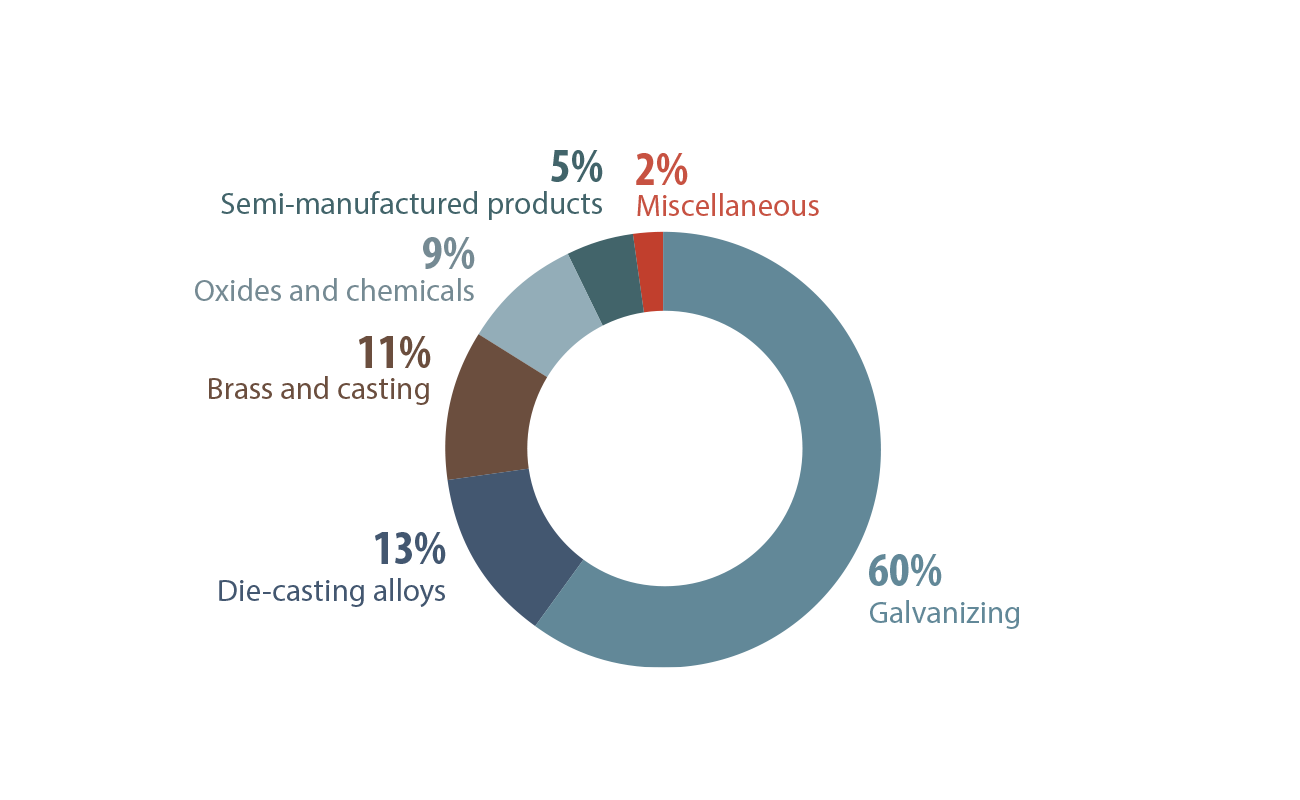
Text version
This pie chart shows the major global uses of zinc in 2022. The largest use is for galvanizing (60%), followed by die-casting alloy production (13%), brass and casting (11%), oxides and chemicals (9%), semi-manufactured products (5%), and other miscellaneous products (2%).
 Production
Production
In 2022, mined zinc production in Canada decreased 22% to 180,256 tonnes from 230,187 tonnes in 2021. Canadian mined zinc production has been generally decreasing since 2013, and while 2023 mined zinc production figures are suppressed by the source, production has likely declined compared to the previous year.
Estimated refined zinc metal production decreased by 6% to 599,899 tonnes in 2022 compared to 640,718 tonnes in 2021. Zinc metal is produced at refineries in British Columbia and Quebec. Refined zinc production is higher compared to mined production since concentrates are imported for processing, notably from Alaska to British Columbia.
Germanium and indium are also recovered as by-products from zinc refining in Canada.
Consult a map of producing Canadian mines
Canadian mine production of zinc, 2013–2022
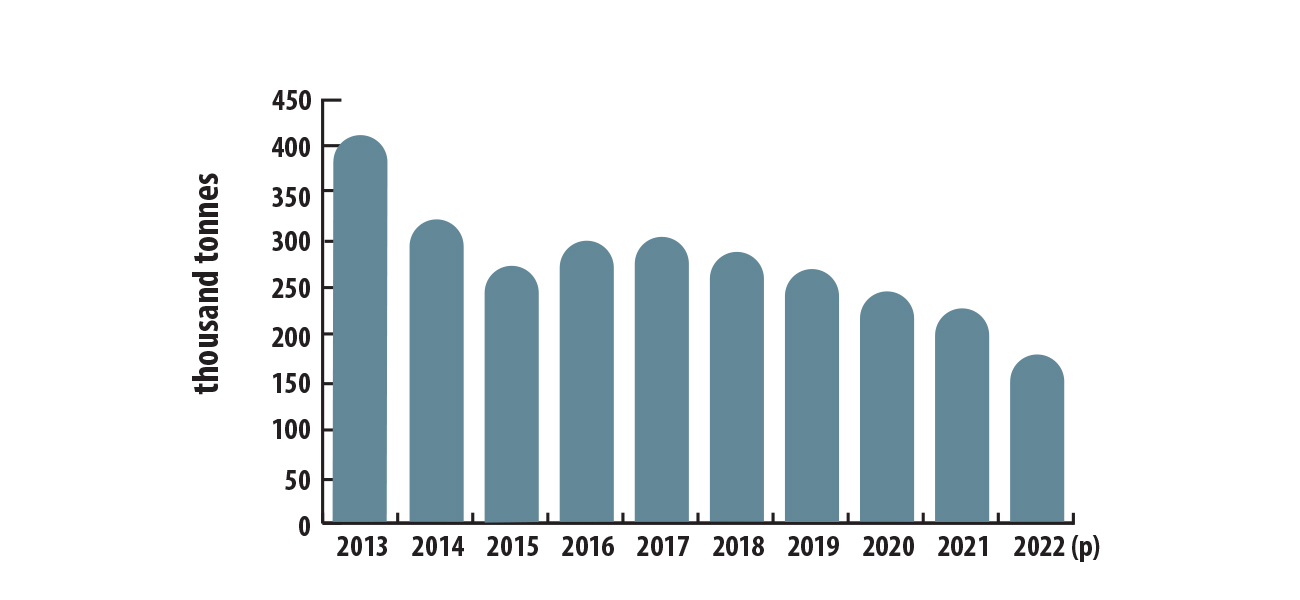
Text version
This bar graph shows Canada’s annual mine production of zinc from 2013 to 2022. Production was at a decade high of 412,277 tonnes in 2013 and decreased to 275,410 tonnes by 2015. Production increased slightly to 301,210 tonnes in 2016 and to 305,314 tonnes in 2017 before decreasing to a decade low of 180,256 tonnes by 2022.
Canadian production of refined zinc, 2013–2022 (p)
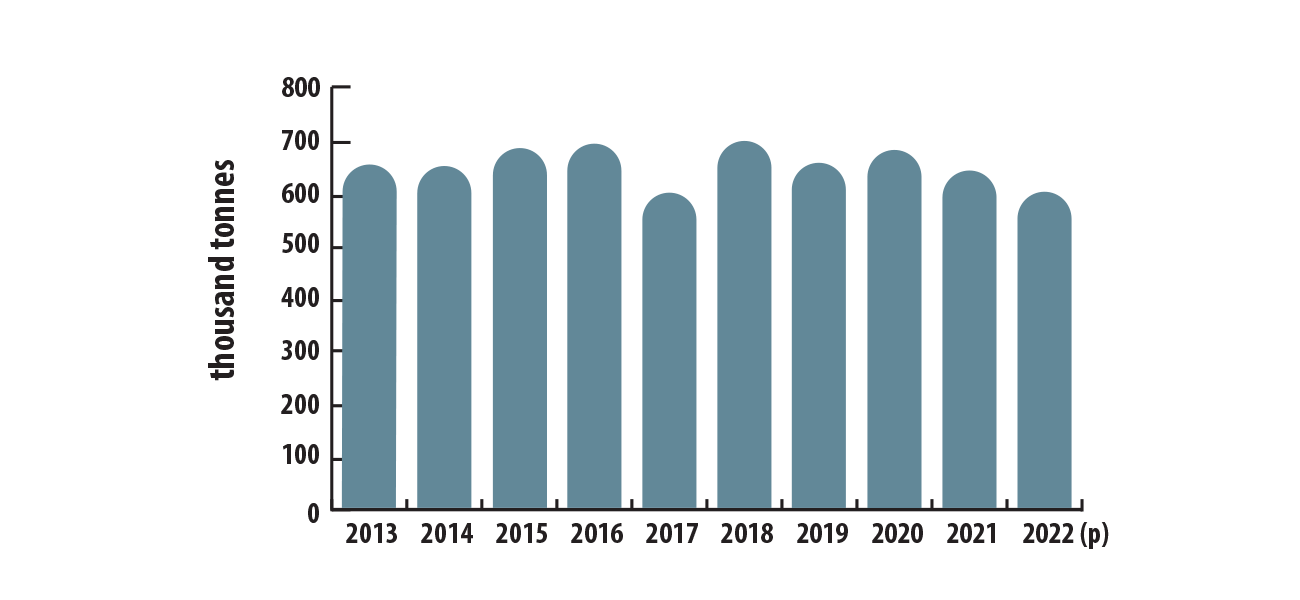
Text version
This bar graph shows Canada’s refined production of zinc from 2013 to 2022. Production was 651,638 tonnes in 2013 and remained relatively stable through 2014 before annual production increased, reaching 691,389 tonnes by 2016. In 2017, production sharply decreased to a decade low of 598,438 tonnes before rebounding to a decade high of 696,591 tonnes in 2018. Production was 640,718 tonnes in 2021 and 599,899 tonnes in 2022.
 International context
International context
World mine production of zinc was 12.0 million tonnes in 2023, which is a 3% increase from the previous year. China was the largest producer of zinc with 4.0 million tonnes or 33% of the global total. Data for Canada was not available for 2023; however, Canada ranked ninth in 2022, accounting for nearly 2% of the global total.
| Ranking | Country | Thousand tonnes | Percentage of total |
|---|---|---|---|
| 1 | China | 4,000 | 33.3% |
| 2 | Peru | 1,400 | 11.7% |
| 3 | Australia | 1,100 | 9.2% |
| 4 | India | 860 | 6.3% |
| 5 | United States | 750 | 5.8% |
| 6 | Mexico | 690 | 5.8% |
| 7 | Bolivia | 490 | 4.1% |
| 8 | Kazakhstan | 330 | 2.8% |
| 9 | Russia | 310 | 2.5% |
| 10 | Sweden | 220 | 1.8% |
| Other countries | 1,800 | 15.0% | |
| World total (rounded) | 12,000 | 100.0% |
World mine production of zinc, 2014-2023 (p)
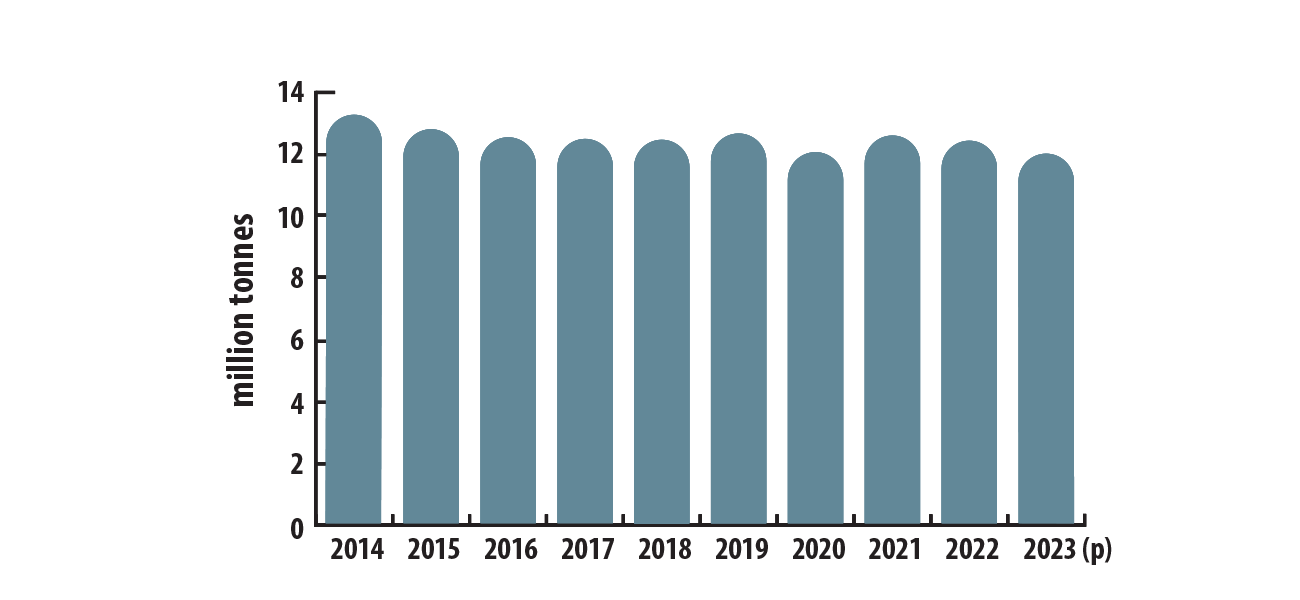
Text version
This bar graph shows the world’s annual mine production of zinc from 2014 to 2023. Production was 13.3 million tonnes in 2014 and decreased annually until it reached 12.5 million tonnes in 2018. Production increased slightly to 12.6 million tonnes in 2019, before decreasing to a decade low of 12.1 million tonnes in 2020. Production then increased, rebounding to 13.0 million tonnes by 2022. Production has once again decreased to 12.0 million tonnes in 2023.
Global production of refined zinc was estimated at 13.9 million tonnes in 2023, a 4% increase over 2022. While data for Canada was not available for 2023, Canada accounted for 4% of global production in 2022.
Global production of refined zinc was estimated at 13.5 million tonnes in 2022, a 5% decrease from 14.1 million tonnes in 2021. Canada accounted for 4% of global production in 2022.
World production of refined zinc, 2014–2023 (p)
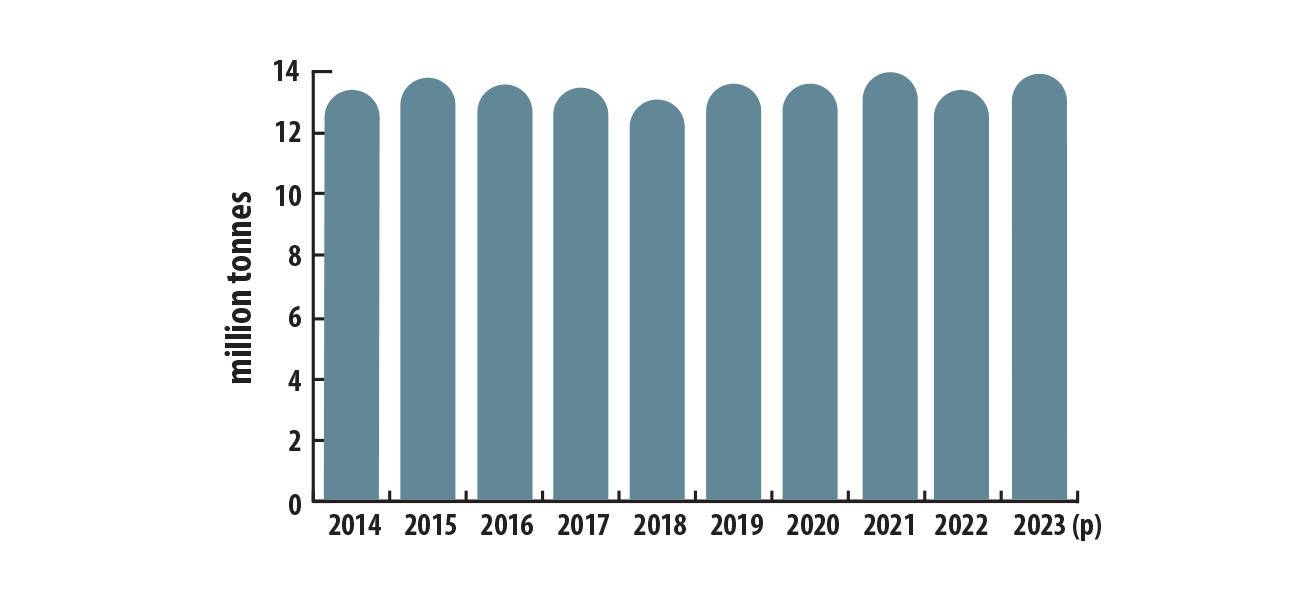
Text version
This bar graph shows the world’s annual production of refined zinc from 2014 to 2023. Production was 13.4 million tonnes in 2014, increasing to 13.8 million tonnes in 2015. Between 2016 and 2018, production decreased annually to 13.1 million tonnes, before increasing to a decade high of 14.1 million tonnes in 2021. Production decreased in 2022 to 13.5 million tonnes, but increased to 13.9 million tonnes in 2023.
World zinc reserves
The world’s zinc reserves were estimated at approximately 224 million tonnes in 2023, according to the U.S. Geological Survey. Australia, China, Russia, Mexico, and Peru were among the nations with the largest zinc reserves.
World zinc reserves, by country, 2022 (p)

Text version
This pie chart shows the estimated world reserves of zinc in 2023, by country and in percentages. Australia had the largest share with 32%, followed by China (22%), Russia (13%), Peru (11%), Mexico (7%), India (4%), Kazakhstan (3%), the United States (3%), Sweden (2%), and Canada and other countries (13%).
 Trade
Trade
Exports
- Canadian exports of zinc and zinc products in 2023 were valued at $2.1 billion.
- In 2023, Canada exported 562,365 tonnes of zinc products, including ore concentrate, zinc oxide, unwrought zinc, and zinc metal products. This represents a 4% increase over 2022.
- Zinc products were exported primarily to the United States (88%), while combined exports to South Korea, Switzerland, Taiwan, and Malaysia made up 9%.
Imports
- In 2023, zinc products imported to Canada were valued at $1.2 billion.
- Canadian smelters imported 577,085 tonnes of zinc in concentrates in 2023, down 4% from 2022.
- Zinc concentrates accounted for 81% of the value of Canada’s zinc imports.
- Concentrates were imported mainly from the United States (53%), followed by Peru (14%), Australia (9%), Mexico (7%), and Bolivia (6%).
 Prices
Prices
Average monthly zinc prices were higher in the early months of 2023 before falling in the latter half of the year and staying low. The average monthly price was US$3,310 per tonne in January, slowly decreasing to US$2,375 in June before slightly increasing to US$2,502 in December, representing a 24% drop in price over the year.
Zinc, average monthly prices, 2014–2023
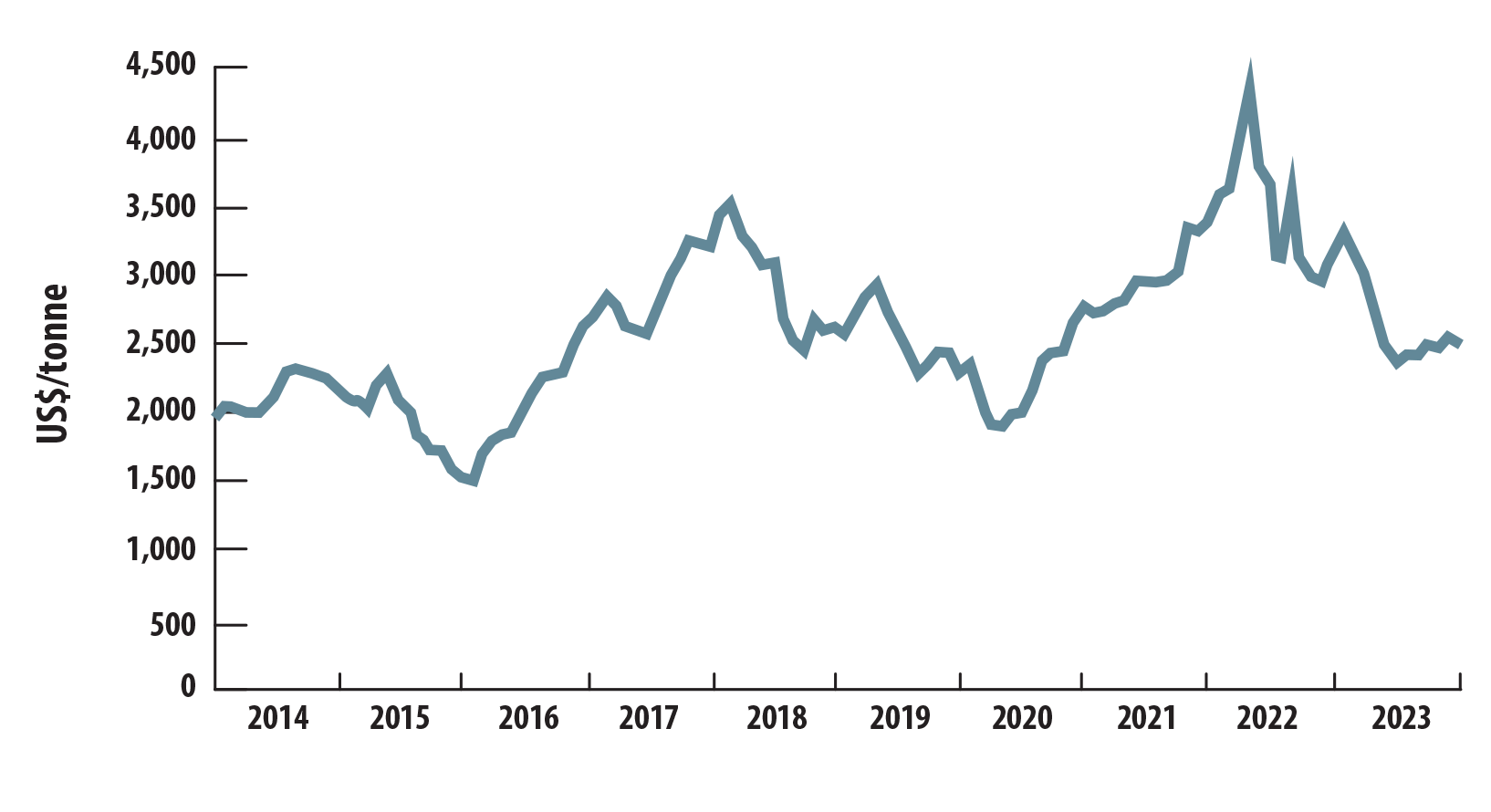
Text version
This line graph plots the monthly average price in US dollars per tonne of zinc from 2014 to 2023. The average annual price of zinc in 2014 was $2,161 per tonne. In January 2016, the average monthly price of zinc reached a decade low of $1,520 per tonne, before increasing to $3,533 per tonne in February 2018. It trended downwards to $1,903 in April 2020, steadily increasing to a decade high of $4,360 in April 2022, with subsequent decreases to $3,129 by December 2022 and $2,502 in December 2023.
Despite the fluctuations, average monthly zinc prices show an overall increasing trend from US$2,032 in January 2013 to US$2,502 in December 2022 (a 23% increase). The average monthly zinc prices for 2023 were $3,310 (January), $3,134 (February), $2,967 (March), $2,768 (April), $2,476 (May), $2,375 (June), $2,405 (July), $2,407 (August), 2,496 (September), $2,449 (October), $2,544 (November), and $2,502 (December).
 Recycling
Recycling
Approximately 34% of worldwide zinc production originates from recycled or secondary zinc. Each year, approximately 20 million tons of zinc enter first use, 39% of which is recycled content. Sources of recycled zinc include scrap galvanized steel and the zinc contained in batteries. Products such as galvanized steel have a long service life, which affects the amount of recyclable material available to the marketplace in any given year.
Notes and sources
(p) preliminary
Totals may be different because of rounding.
All dollars are Canadian unless otherwise indicated.
Uses
- Zinc, global uses, 2022
- Wood Mackenzie
Production
- Canadian mine production of zinc, 2013–2022 (p)
- Natural Resources Canada
- Data for 2023 were suppressed by Statistics Canada to meet the confidentiality requirements of the Statistics Act.
- Canadian production of refined zinc, 2013–2022 (p)
- Statistics Canada
- Data for January 2020 and July to December 2022 were suppressed by Statistics Canada to meet the confidentiality requirements of the Statistics Act.
- Refined zinc production in January 2020 is estimated based on the average of reported monthly production from February 2020 to January 2021. Similarly, production for July to December 2020 is estimated based on the average of reported monthly production from July 2021 to June 2022.
- Data for 2023 were suppressed by Statistics Canada to meet the confidentiality requirements of the Statistics Act.
- Natural Resources Canada, Map 900A
- Statistics Canada
International context
- World mine production of zinc, by country, 2023 (p)
- U.S. Geological Survey
- Natural Resources Canada; Statistics Canada (Canadian Statistics)
- World mine production of zinc, 2014–2023 (p)
- U.S. Geological Survey
- Natural Resources Canada; Statistics Canada (Canadian Statistics)
- World production of refined zinc, 2014–2023 (p)
- U.S. Geological Survey
- Natural Resources Canada; Statistics Canada
- World zinc reserves, by country, 2023 (p)
- U.S. Geological Survey
Trade
- Imports and exports of Canadian zinc, 2023 (p)
- Natural Resources Canada; Statistics Canada
- Mineral trade includes ores, concentrates, and semi- and final-fabricated mineral products.
Prices
- Zinc, average monthly prices, 2014–2023
- World Bank Commodities
Recycling
- International Zinc Association